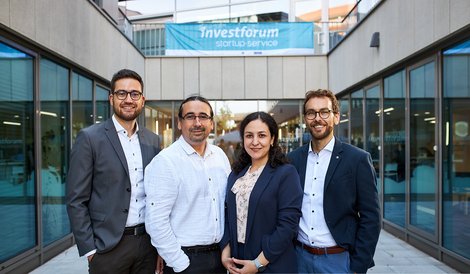Listening at the keyhole
A medical technology start-up from Saxony-Anhalt is revolutionizing keyhole surgery
Small incisions and rapid healing: minimally invasive surgery brings many benefits and has been part of everyday clinical practice for several decades. SURAG Medical GmbH aims to give surgeons additional audio support. The start-up from Magdeburg has developed a system that listens to the surgical instrument and provides information in real time. This could make keyhole surgery safer and more precise.
At SURAG Medical GmbH they bring out the good old tin can telephone to demonstrate to people without a medical or technical background how their innovation works. Moritz Spiller vibrates the string and a noise can be heard in the tin cans at each end. “In principle that’s what we are doing,” he says. “We’re making interactions audible.” The Chief Commercial Officer of the company makes it sound so simple, but in combination with the innovation introduced by the young company it represents a milestone in the world of surgery. Years of development work and the experience of users have gone into the innovative plug-and-play system that “listens” to the interaction between the instrument and the tissue and transforms it into perceptible feedback.
Reducing the risk of damage to blood vessels
Moritz Spiller starts another demonstration by pushing a needle through simulated tissue. A small black device is fixed to the needle. If the biopsy needle meets with resistance, it can indicate this to the surgeon in audible or visual form. The fact that the prototype of the instrument exists is down to the persistence, expertise and research abilities of the six-person team of specialists. It is all based on an idea from Dr. Alfredo Illanes, now the team leader at SURAG and senior research scientist in the INKA research group, which is part of the medical faculty of Otto von Guericke University (OVGU). One evening in his office he put a stethoscope on a biopsy needle, moved it over a surface and listened carefully. This was the moment when the idea for SURAG or Surgical Audio Guidance was born, which gives the company its name and has initiated a development that could fill a gap in the field of minimally invasive surgery. It will allow surgeons to position and move their instruments more precisely. As Moritz Spiller explains: “This will help to avoid damage to organs and blood vessels and reduce costs for the healthcare system.”
Support from the German government’s EXIST Transfer of Research
The team has underpinned its development activities with the experiences of many prominent medical specialists from a variety of surgical disciplines. From the very start, they have helped to ensure that the development from Magdeburg meets surgeons’ needs and the requirements of clinical practice. The concept has also received national and regional awards, such as the Hugo Junkers prize for research and innovation from Saxony-Anhalt. In 2020, the start-up project was granted two years of funding from the German government and the European Union via the EXIST Transfer of Research program. The state of Saxony-Anhalt is also supporting the young company with egoStart funding.
Market launch by 2025 at the latest
Moritz Spiller explains that the team of developers from the fields of engineering, IT and medicine are focusing on the market launch. There is a clear strategy: by 2025 at the latest SURAG will be in use in German operating theaters and later in those in the USA for laparoscopies and other minimally invasive procedures. Until then, the team is working on improvements such as smaller and lighter components and obtaining feedback from surgeons and designers, according to Moritz Spiller. He is a graduate of OVGU and currently responsible for software development and commercialization at SURAG. He looks around his rooms at the University Hospital Magdeburg and says: “The conditions here are ideal for us.”
Wide-ranging network
At the hospital, the young company is supported by the INKA research group, which stands for Innovation Laboratory for Image Guided Therapy. Alongside the team’s core competencies and the help of the department of their mentor and start-up member Professor Michael Friebe, SURAG also benefits from a wide-ranging network of prestigious hospitals and research institutions. The department for Computer Aided Medical Procedures & Augmented Reality at TU Munich is also involved.
Success in the Fight Club of the Start-up Safari Saxony-Anhalt
One of the major challenges over the coming months will be to find venture capital companies that will put their trust and their funding into the start-up and its development. “Specifically this will allow us to adapt our internal processes to meet regulatory requirements and to finish developing our clinical demonstrator,” explains Moritz Spiller. Clinical studies, certification processes and achieving visibility are now on the agenda. For example, by taking part in the annual biomedical technology conference in Hanover where SURAG was rated “most popular start-up” by the participants and by joining in the Start-up Safari Saxony-Anhalt. At this annual event for the local start-up scene, organized by the FOUND IT! start-up center of the Anhalt University of Applied Sciences and the venture capital company bmp Venture AG, the Magdeburg team presented their business idea in a pitch as part of the Fight Club in the boxing ring in Bernburg (Saale).
The vision is a platform technology with a variety of applications
The start-up from Saxony-Anhalt is never reticent about its long-term vision: “As a platform technology, SURAG can be adapted to a variety of applications,” says Spiller, who has chosen Magdeburg as his home. The team already has five applications in the pipeline and the potential is almost limitless, with 20 million needle interventions being carried out worldwide every year, alongside 13 million laparoscopies, 21,000 deployments of surgical robots by 2030 and four million knee arthroscopies.
Author: Manuela Bock/IMG Saxony-Anhalt

